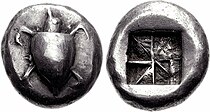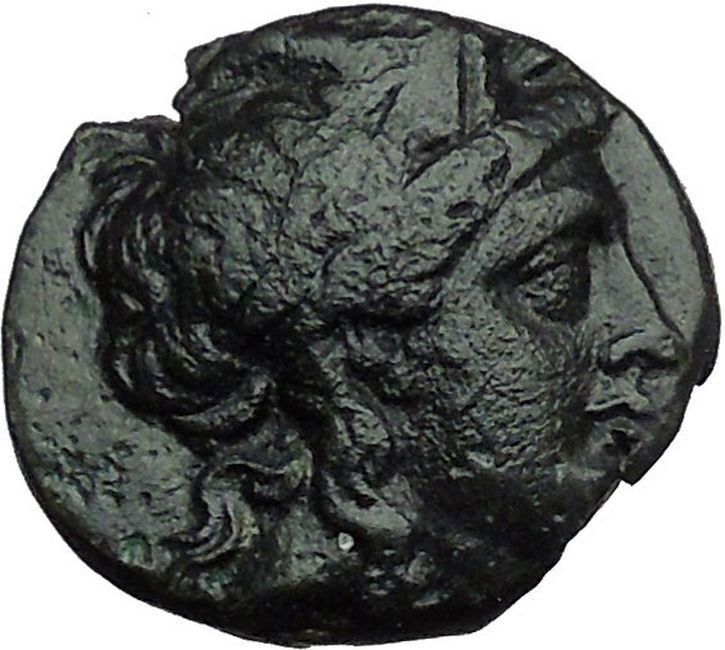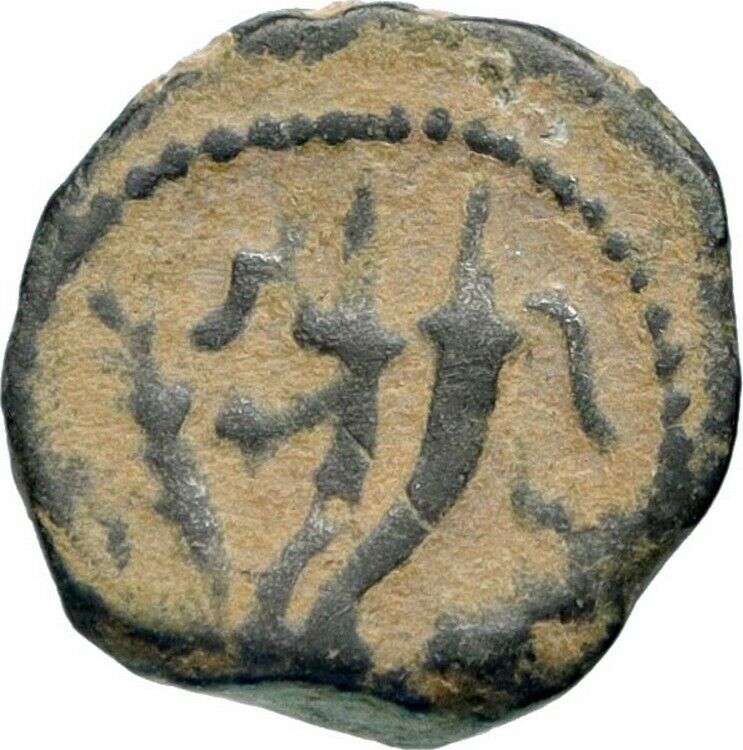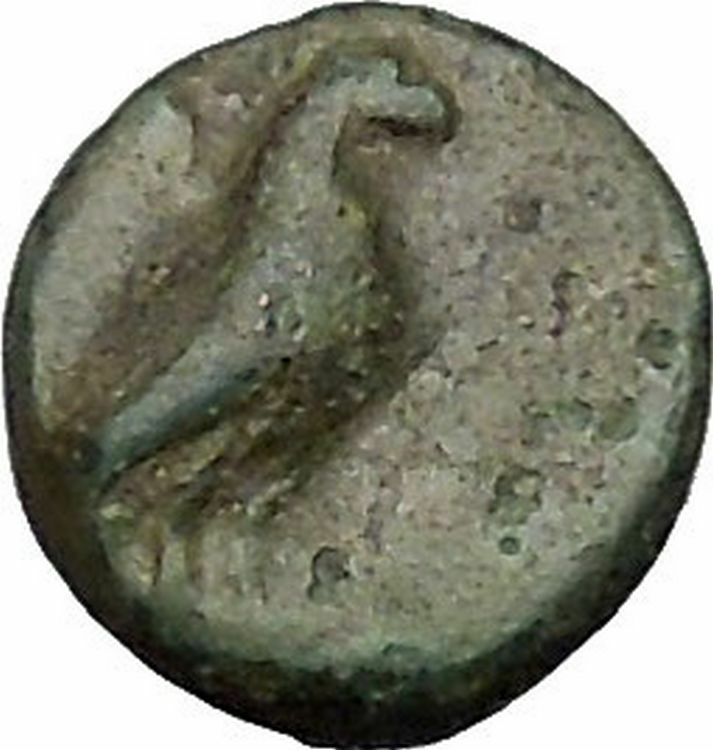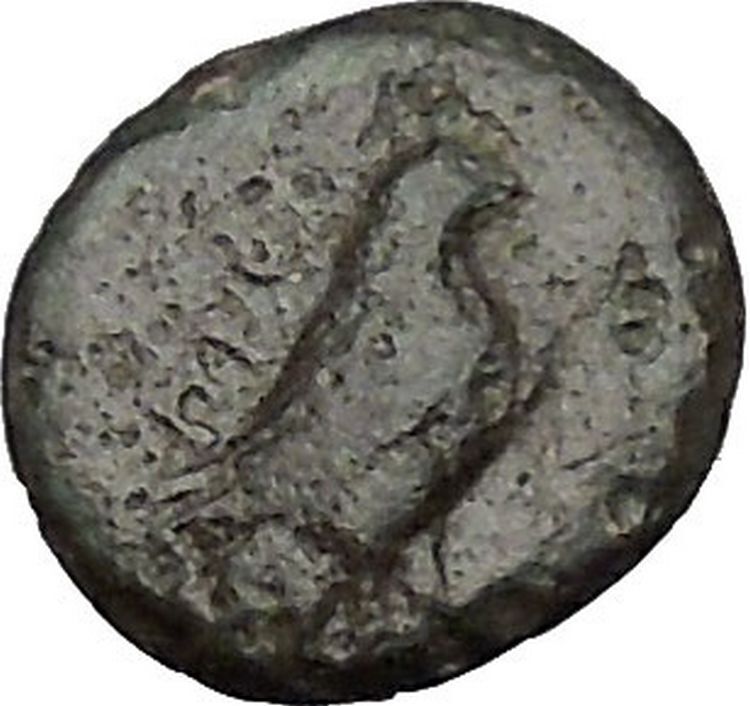|
Greek city of Maroneia in Thrace
Bronze 14mm (2.35 gm.) Struck 400-350 B.C.
Reference: Sear 1636; B.M.C. 3.65
Horse prancing right; monogram beneath.
ΜΑΡΩΝΙΤΩΝ around three sides of linear square containing vine; monogram beneath.
You are bidding on the exact item pictured,
provided with a Certificate of Authenticity and Lifetime Guarantee of
Authenticity.
Maroneia is a municipality in the
Rhodope Prefecture
,
Greece
.
Population 7,644 (2001). The seat of the municipality is in
Xylagani
.
In legend, it was said to have been founded by Maron, a son
of Dionysus
,
or even a companion of
Osiris
.
According to
Pseudo-Scymnus
it was founded by
Chios
in the
first half of the 6th century BC.
According to
Pliny
, its ancient name was Ortagures.
It was located on the hill of Aghios Gheorgis, and archaeological findings date
it as a much older and as a pure
Thracian
city.
Maroneia was close to the
Ismaros
mentioned by
Homer
in the
Odyssey
.
Some scholars identify Maroneia with his Ismaros.
Homer has Odysseus
plundering the city but sparing Maron, whom he identifies as a
priest of Apollo
.
Maron presents Odysseus with a gift of
wine, as well as
with gold and silver.
In the era of
Ancient Greece
and
Rome
,
Maroneia was famous for its wine production. The wine was esteemed everywhere;
it was said to possess the odor of
nectar
, and to
be capable of mixture with twenty or more times its quantity with water.
That the people of Maroneia venerated
Dionysus
,
we learn not just from its famous Dionysian Sanctuary, the foundations of which
can still be seen today, but also from the city’s coins.
In
200 BC
it was
taken by
Philip V of Macedon
, who vented his rage by slaughtering a great number of
the city’s inhabitants.
The Roman Republic
subsequently granted Maroneia to
Attalus
, King of
Pergamon
,
but almost immediately revoked their gift and declared it a free city.
Thrace (demonym Thracian
/
ənθreɪʃⁱˈ/;
Bulgarian
:
Тракия, Trakiya,
Greek
: Θράκη,
Thráki,
Turkish
:
Trakya) is a historical and geographic area in southeast
Europe
. As a geographical concept, Thrace
designates a region bounded by the
Balkan Mountains
on the north,
Rhodope Mountains
and the
Aegean Sea
on the south, and by the
Black Sea
and the
Sea of Marmara
on the east. The areas it
comprises are southeastern
Bulgaria
(Northern
Thrace), northeastern
Greece
(Western
Thrace), and the European part of
Turkey
(Eastern
Thrace). The biggest part of Thrace is part of present-day Bulgaria.
In Turkey, it is also called
Rumelia
. The name comes from the
Thracians
, an ancient
Indo-European
people inhabiting Southeastern
Europe.
The historical boundaries of Thrace have varied. Noteworthy is the fact that,
at an early date, the
ancient Greeks
employed the term “Thrace” to
refer to all of the territory which lay north of
Thessaly
inhabited by the
Thracians
,[1]
a region which “had no definite boundaries” and to which other regions (like
Macedonia
and even
Scythia
) were added.[2]
In one ancient Greek source, the very Earth is divided into “Asia, Libya, Europa
and Thracia”.[2]
As the knowledge of world geography of the Greeks broadened, the term came to be
more restricted in its application: Thrace designated the lands bordered by the
Danube
on the north, by the Euxine Sea (Black
Sea) on the east, by northern
Macedonia
in the south and by the
Illyrian
lands (i.e.
Illyria
) to the west.[2]
This largely coincided with the Thracian
Odrysian kingdom
, whose borders varied in time.
During this time, specifically after the Macedonian conquest, the region’s old
border with Macedonia was shifted from the
Struma River
to the
Mesta River
.[3][4]
This usage lasted until the Roman conquest. Henceforth, (classical) Thrace
referred only to the tract of land largely covering the same extent of space as
the modern geographical region. In its early period, the
Roman province of Thrace
was of this extent,
but after the administrative reforms of the late 3rd century, Thracia’s much
reduced territory became the six small provinces which constituted the
Diocese of Thrace
. The medieval
Byzantine
theme
of
Thrace
contained only what today is
Eastern Thrace
.
The largest cities of Thrace are:
İstanbul
(European side),
Plovdiv
,
Burgas
,
Stara Zagora
,
Haskovo
,
Edirne
,
Çorlu
and
Tekirdag
.
Most of the Bulgarian and Greek population are Christians, while most of the
Turkish inhabitants of Thrace are Muslims.
Thrace in
ancient Greek mythology
Ancient Greek mythology
provides them with a
mythical ancestor, named
Thrax
, son of the war-god
Ares, who was said to reside in Thrace. The Thracians appear in
Homer
‘s
Iliad
as
Trojan allies, led by
Acamas
and
Peiros
. Later in the Iliad,
Rhesus
, another Thracian king, makes an
appearance. Cisseus
, father-in-law to the Trojan elder
Antenor
, is also given as a Thracian king.
Homeric Thrace was vaguely defined, and stretched from the River
Axios
in the west to the
Hellespont
and
Black Sea
in the east. The
Catalogue of Ships
mentions three separate
contingents from Thrace: Thracians led by Acamas and Peiros, from
Aenus
;
Cicones
led by
Euphemus
, from southern Thrace, near
Ismaros
; and from the city of
Sestus
, on the Thracian (northern) side of the
Hellespont, which formed part of the contingent led by
Asius
. Greek mythology is replete with Thracian
kings, including
Diomedes
,
Tereus
,
Lycurgus
,
Phineus
,
Tegyrius
,
Eumolpus
,
Polymnestor
,
Poltys
, and
Oeagrus
(father of
Orpheus
). In addition to the tribe that Homer
calls Thracians, ancient Thrace was home to numerous other tribes, such as the
Edones
,
Bisaltae
,
Cicones
, and
Bistones
.
Thrace is also mentioned in Ovid’s Metamorphoses in the episode of
Philomela
, Procne, and
Tereus
. Tereus, the King of Thrace, lusts after
his sister-in-law, Philomela. He kidnaps her, holds her captive, rapes her, and
cuts out her tongue. Philomela manages to get free, however. She and her sister,
Procne, plot to get revenge, by killing Itys (son of Tereus and Procne) and
serving him to his father for dinner. At the end of the myth, all three turn
into birds—Procne, a swallow; Philomela, a nightingale; and Tereus, a
hoopoe
.
History
Ancient history
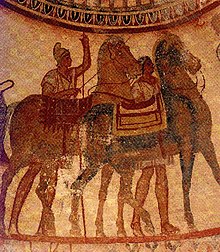
Thracian Tomb of Kazanlak
The indigenous population of Thrace was a people called the
Thracians
, divided into numerous tribal groups.
Thracian troops were known to accompany neighboring ruler
Alexander the Great
when he crossed the
Hellespont
which abuts Thrace, and took on the
Persian Empire
of the day.
The Thracians did not describe themselves as such and Thrace and
Thracians are simply the names given them by the Greeks.[5]
Divided into separate tribes, the Thracians did not manage to form a lasting
political organization until the
Odrysian state
was founded in the 4th century
BC. Like Illyrians
, Thracian tribes of the mountainous
regions fostered a locally ruled warrior tradition, while the tribes based in
the plains were purportedly more peaceable. Recently discovered funeral mounds
in Bulgaria suggest that Thracian kings did rule regions of Thrace with distinct
Thracian national identity.
During this period, a subculture of
celibate
ascetics
called the
Ctistae
lived in Thrace, where they served as
philosophers, priests and prophets.
Medieval history
By the mid 5th century, as the Roman Empire began to crumble, Thracia fell
from the authority of Rome and into the hands of Germanic tribal rulers. With
the fall of Rome, Thracia turned into a battleground territory for the better
part of the next 1,000 years. The eastern successor of the
Roman Empire
in the Balkans, the
Byzantine Empire
, retained control over Thrace
until the 8th century when the northern half of the entire region was
incorporated into the
First Bulgarian Empire
. Byzantium regained
Thrace in the late 10th century and administered it as a
theme
, until the Bulgarians regained
control of the northern half at the end of the 12th century. Throughout the 13th
century and the first half of the 14th century, the region was changing in the
hands of the Bulgarian and the Byzantine Empire(excl. Constantinopole). In 1265
the area suffered a Mongol raid from the
Golden Horde
, led by
Nogai Khan
. In 1352, the
Ottoman
Turks
conducted their first incursion into the
region subduing it completely within a matter of two decades and occupying it
for five centuries.
Modern history
With the
Congress of Berlin
in 1878, Northern Thrace was
incorporated into the semi-autonomous Ottoman province of
Eastern Rumelia
, which united with Bulgaria in
1885. The rest of Thrace was divided among Bulgaria, Greece and Turkey at the
beginning of the 20th century, following the
Balkan Wars
,
World War I
and the
Greco-Turkish War
. Today Thracian is a
strong regional identity in Greece, Turkey, Bulgaria and other neighbouring
countries.
Famous Thracians and people from Thrace
- A number of
Roman emperors
of the 3rd-5th century were
of Thraco-Roman
backgrounds (Maximinus
Thrax,
Licinius
,
Galerius
,
Aureolus
,
Leo the Thracian
, etc.). These emperors
were elevated via a military career, from the condition of common soldiers
in one of the
Roman legions
to the foremost positions of
political power
.
The history of
Ancient Greek
coinage can be divided (along
with most other Greek art forms) into four periods, the
Archaic
, the
Classical
, the
Hellenistic
and the
Roman
. The Archaic period extends from the
introduction of coinage to the Greek world during the
7th century BC
until the
Persian Wars
in about 480 BC. The Classical
period then began, and lasted until the conquests of
Alexander the Great
in about 330 BC, which
began the Hellenistic period, extending until the
Roman
absorption of the Greek world in the 1st
century BC. The Greek cities continued to produce their own coins for several
more centuries under Roman rule. The coins produced during this period are
called
Roman provincial coins
or Greek Imperial Coins.
Ancient Greek coins of all four periods span over a period of more than ten
centuries.
Weight
standards and denominations

Above: Six rod-shaped obeloi (oboloi) displayed at the
Numismatic Museum of Athens
,
discovered at
Heraion of Argos
. Below: grasp[1]
of six oboloi forming one drachma

Electrum
coin from
Ephesus
, 620-600 BC, known as
Phanes’ coin
. Obverse:
Stag
grazing, ΦΑΝΕΩΣ (retrograde).
Reverse: Two incuse punches.
The basic standards of the Ancient Greek monetary system were the
Attic
standard, based on the Athenian
drachma
of 4.3 grams of silver and the
Corinthian
standard based on the
stater
of 8.6 grams of silver, that was
subdivided into three silver drachmas of 2.9 grams. The word
drachm
(a) means “a handful”, literally “a
grasp”. Drachmae were divided into six
obols
(from the Greek word for a
spit
), and six spits made a “handful”. This
suggests that before coinage came to be used in Greece, spits in
prehistoric times
were used as measures of
daily transaction. In archaic/pre-numismatic times iron was valued for making
durable tools and weapons, and its casting in spit form may have actually
represented a form of transportable
bullion
, which eventually became bulky and
inconvenient after the adoption of precious metals. Because of this very aspect,
Spartan
legislation famously forbade issuance
of Spartan coin, and enforced the continued use of iron spits so as to
discourage avarice and the hoarding of wealth. In addition to its original
meaning (which also gave the
euphemistic
diminutive
“obelisk“,
“little spit”), the word obol (ὀβολός, obolós, or ὀβελός,
obelós) was retained as a Greek word for coins of small value, still used as
such in Modern Greek
slang (όβολα, óvola,
“monies”).
The obol was further subdivided into tetartemorioi (singular
tetartemorion) which represented 1/4 of an obol, or 1/24 of a drachm. This
coin (which was known to have been struck in
Athens
,
Colophon
, and several other cities) is
mentioned by Aristotle
as the smallest silver coin.:237
Various multiples of this denomination were also struck, including the
trihemitetartemorion (literally three half-tetartemorioi) valued at 3/8 of
an obol.:
| Denominations of silver drachma |
| Image |
Denomination |
Value |
Weight |
|
|
Dekadrachm |
10 drachmas |
43 grams |
|
|
Tetradrachm |
4 drachmas |
17.2 grams |
|
|
Didrachm |
2 drachmas |
8.6 grams |
|
|
Drachma |
6 obols |
4.3 grams |
|
|
Tetrobol |
4 obols |
2.85 grams |
|
|
Triobol (hemidrachm) |
3 obols |
2.15 grams |
|
|
Diobol |
2 obols |
1.43 grams |
|
|
Obol |
4 tetartemorions |
0.72 grams |
|
|
Tritartemorion |
3 tetartemorions |
0.54 grams |
|
|
Hemiobol |
2 tetartemorions |
0.36 grams |
|
|
Trihemitartemorion |
3/2 tetartemorions |
0.27 grams |
|
|
Tetartemorion |
|
0.18 grams |
|
|
Hemitartemorion |
½ tetartemorion |
0.09 grams |
Archaic period
Archaic coinage
Uninscribed
electrum
coin from
Lydia
, 6th century BCE.
Obverse: lion head and sunburst Reverse: plain square
imprints, probably used to standardise weight
Electrum
coin from
Ephesus
, 620-600 BC. Obverse:
Forepart of stag. Reverse: Square incuse punch.
The first coins were issued in either Lydia or Ionia in Asia Minor at some
time before 600 BC, either by the non-Greek Lydians for their own use or perhaps
because Greek mercenaries wanted to be paid in precious metal at the conclusion
of their time of service, and wanted to have their payments marked in a way that
would authenticate them. These coins were made of
electrum
, an alloy of gold and silver that was
highly prized and abundant in that area. By the middle of the 6th century BC,
technology had advanced, making the production of pure gold and silver coins
simpler. Accordingly, King
Croesus
introduced a bi-metallic standard that
allowed for coins of pure gold and pure silver to be struck and traded in the
marketplace.
Coins of Aegina
Silver
stater
of Aegina, 550-530 BC.
Obv.
Sea turtle
with large pellets
down center. Rev. incuse square with eight sections. After the
end of the
Peloponnesian War
, 404 BC, Sea
turtle was replaced by the land
tortoise
.
Silver
drachma
of Aegina, 404-340 BC.
Obverse: Land
tortoise
. Reverse: inscription
AΙΓ[INAΤΟΝ] ([of the] Aeg[inetans]) “Aegina” and dolphin.
The Greek world was divided into more than two thousand self-governing
city-states (in
Greek
, poleis), and more than half of
them issued their own coins. Some coins circulated widely beyond their polis,
indicating that they were being used in inter-city trade; the first example
appears to have been the silver stater or didrachm of
Aegina
that regularly turns up in hoards in
Egypt
and the
Levant
, places which were deficient in silver
supply. As such coins circulated more widely, other cities began to mint coins
to this “Aeginetan” weight standard of (6.1 grams to the drachm), other cities
included their own symbols on the coins. This is not unlike present day
Euro coins, which are recognisably from a particular country, but
usable all over the
Euro zone
.
Athenian coins, however, were struck on the “Attic” standard, with a drachm
equaling 4.3 grams of silver. Over time, Athens’ plentiful supply of silver from
the mines at
Laurion
and its increasing dominance in trade
made this the pre-eminent standard. These coins, known as “owls” because of
their central design feature, were also minted to an extremely tight standard of
purity and weight. This contributed to their success as the premier trade coin
of their era. Tetradrachms on this weight standard continued to be a widely used
coin (often the most widely used) through the classical period. By the time of
Alexander the Great
and his
Hellenistic successors
, this large denomination
was being regularly used to make large payments, or was often saved for
hoarding.
Classical period
A
Syracusan
tetradrachm
(c. 415–405
BC)
Obverse: head of the
nymph
Arethusa
, surrounded by
four swimming
dolphins
and a
rudder
Reverse: a racing
quadriga
, its
charioteer
crowned by the
goddess
Victory
in flight.
Tetradrachm of Athens, (5th century BC)
Obverse: a portrait of
Athena
, patron goddess of
the city, in
helmet
Reverse: the owl of Athens, with an
olive
sprig and the
inscription “ΑΘΕ”, short for ΑΘΕΝΑΙΟΝ, “of the
Athenians
“
The
Classical period
saw Greek coinage reach a high
level of technical and aesthetic quality. Larger cities now produced a range of
fine silver and gold coins, most bearing a portrait of their patron god or
goddess or a legendary hero on one side, and a symbol of the city on the other.
Some coins employed a visual pun: some coins from
Rhodes
featured a
rose, since the Greek word for rose is rhodon. The use of
inscriptions on coins also began, usually the name of the issuing city.
The wealthy cities of Sicily produced some especially fine coins. The large
silver decadrachm (10-drachm) coin from
Syracuse
is regarded by many collectors as the
finest coin produced in the ancient world, perhaps ever. Syracusan issues were
rather standard in their imprints, one side bearing the head of the nymph
Arethusa
and the other usually a victorious
quadriga
. The
tyrants of Syracuse
were fabulously rich, and
part of their
public relations
policy was to fund
quadrigas
for the
Olympic chariot race
, a very expensive
undertaking. As they were often able to finance more than one quadriga at a
time, they were frequent victors in this highly prestigious event.
Syracuse was one of the epicenters of numismatic art during the classical
period. Led by the engravers Kimon and Euainetos, Syracuse produced some of the
finest coin designs of antiquity.
Hellenistic period

Gold 20-stater
of
Eucratides I
, the largest gold coin
ever minted in Antiquity.

Drachma of
Alexandria
, 222-235 AD. Obverse:
Laureate head of
Alexander Severus
, KAI(ΣΑΡ)
MAP(ΚΟΣ) AYP(ΗΛΙΟΣ) ΣЄY(ΑΣΤΟΣ) AΛЄΞANΔPOΣ ЄYΣЄ(ΒΗΣ). Reverse: Bust
of
Asclepius
.
The Hellenistic period was characterized by the spread of Greek
culture across a large part of the known world. Greek-speaking kingdoms were
established in Egypt
and
Syria
, and for a time also in
Iran and as far east as what is now
Afghanistan
and northwestern
India
. Greek traders spread Greek coins across
this vast area, and the new kingdoms soon began to produce their own coins.
Because these kingdoms were much larger and wealthier than the Greek city states
of the classical period, their coins tended to be more mass-produced, as well as
larger, and more frequently in gold. They often lacked the aesthetic delicacy of
coins of the earlier period.
Still, some of the
Greco-Bactrian
coins, and those of their
successors in India, the
Indo-Greeks
, are considered the finest examples
of
Greek numismatic art
with “a nice blend of
realism and idealization”, including the largest coins to be minted in the
Hellenistic world: the largest gold coin was minted by
Eucratides
(reigned 171–145 BC), the largest
silver coin by the Indo-Greek king
Amyntas Nikator
(reigned c. 95–90 BC). The
portraits “show a degree of individuality never matched by the often bland
depictions of their royal contemporaries further West” (Roger Ling, “Greece and
the Hellenistic World”).
The most striking new feature of Hellenistic coins was the use of portraits
of living people, namely of the kings themselves. This practice had begun in
Sicily, but was disapproved of by other Greeks as showing
hubris
(arrogance). But the kings of
Ptolemaic Egypt
and
Seleucid Syria
had no such scruples: having
already awarded themselves with “divine” status, they issued magnificent gold
coins adorned with their own portraits, with the symbols of their state on the
reverse. The names of the kings were frequently inscribed on the coin as well.
This established a pattern for coins which has persisted ever since: a portrait
of the king, usually in profile and striking a heroic pose, on the obverse, with
his name beside him, and a coat of arms or other symbol of state on the reverse.
Minting
All Greek coins were
handmade
, rather than machined as modern coins
are. The design for the obverse was carved (in
incuso
) into a block of bronze or possibly
iron, called a
die
. The design of the reverse was carved into
a similar punch. A blank disk of gold, silver, or electrum was cast in a mold
and then, placed between these two and the punch struck hard with a hammer,
raising the design on both sides of the coin.
Coins as
a symbol of the city-state
Coins of Greek city-states depicted a unique
symbol
or feature, an early form of
emblem
, also known as
badge
in numismatics, that represented their
city and promoted the prestige of their state. Corinthian stater for example
depicted pegasus
the mythological winged stallion, tamed
by their hero
Bellerophon
. Coins of
Ephesus
depicted the
bee
sacred to
Artemis
. Drachmas of Athens depicted the
owl of Athena
. Drachmas of
Aegina
depicted a
chelone
. Coins of
Selinunte
depicted a “selinon” (σέλινον
– celery
). Coins of
Heraclea
depicted
Heracles
. Coins of
Gela depicted a man-headed bull, the personification of the river
Gela
. Coins of
Rhodes
depicted a “rhodon” (ῥόδον[8]
– rose
). Coins of
Knossos
depicted the
labyrinth
or the mythical creature
minotaur
, a symbol of the
Minoan Crete
. Coins of
Melos
depicted a “mēlon” (μήλον –
apple
). Coins of
Thebes
depicted a Boeotian shield.
Corinthian stater with
pegasus
Coin of
Rhodes
with a
rose
Didrachm of
Selinunte
with a
celery
Coin of
Ephesus
with a
bee
Stater of
Olympia
depicting
Nike
Coin of
Melos
with an
apple
Obolus from
Stymphalia
with a
Stymphalian bird
Coin of
Thebes
with a Boeotian shield
Coin of Gela
with a man-headed bull,
the personification of the river
Gela
Didrachm of
Knossos
depicting the
Minotaur
Commemorative coins

Dekadrachm
of
Syracuse
[disambiguation
needed]. Head of Arethusa or queen
Demarete. ΣΥΡΑΚΟΣΙΟΝ (of the Syracusians), around four dolphins
The use of
commemorative coins
to celebrate a victory or
an achievement of the state was a Greek invention. Coins are valuable, durable
and pass through many hands. In an age without newspapers or other mass media,
they were an ideal way of disseminating a political message. The first such coin
was a commemorative decadrachm issued by
Athens
following the Greek victory in the
Persian Wars
. On these coins that were struck
around 480 BC, the owl
of Athens, the goddess
Athena
‘s sacred bird, was depicted facing the
viewer with wings outstretched, holding a spray of olive leaves, the
olive tree
being Athena’s sacred plant and also
a symbol of peace and prosperity. The message was that Athens was powerful and
victorious, but also peace-loving. Another commemorative coin, a silver
dekadrachm known as ” Demareteion”, was minted at
Syracuse
at approximately the same time to
celebrate the defeat of the
Carthaginians
. On the obverse it bears a
portrait of
Arethusa
or queen Demarete.
Ancient Greek coins
today
Collections of Ancient Greek coins are held by museums around the world, of
which the collections of the
British Museum
, the
American Numismatic Society
, and the
Danish National Museum
are considered to be the
finest. The American Numismatic Society collection comprises some 100,000
ancient Greek coins from many regions and mints, from Spain and North Africa to
Afghanistan. To varying degrees, these coins are available for study by
academics and researchers.
There is also an active collector market for Greek coins. Several auction
houses in Europe and the United States specialize in ancient coins (including
Greek) and there is also a large on-line market for such coins.
Hoards of Greek coins are still being found in Europe, Middle East, and North
Africa, and some of the coins in these hoards find their way onto the market.
Coins are the only art form from the Ancient world which is common enough and
durable enough to be within the reach of ordinary collectors.
|


